Mata Hari
| Mata Hari | |
|---|---|
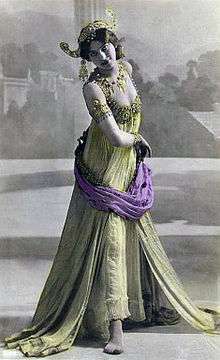 1906 postcard (colorized) | |
| Born |
Margaretha Geertruida Zelle 7 August 1876 Leeuwarden, Netherlands |
| Died |
15 October 1917 (aged 41) Vincennes, Paris, France |
| Cause of death | Execution by firing squad |
| Nationality | Dutch |
| Known for | Receiving a conviction for pro-German espionage from French military courts in World War I |
| Height | 5 ft 10 in (1.78 m) |
| Spouse(s) | Rudolf John MacLeod (1895–1906) (divorced) |
| Children | 2 |
| Parent(s) |
Adam Zelle Antje van der Meulen |
Margaretha Geertruida "Margreet" MacLeod (born Zelle; 7 August 1876 – 15 October 1917), better known by the stage name Mata Hari, was a Dutch exotic dancer and courtesan who was convicted of being a spy[1] and executed by firing squad in France under charges of espionage for Germany during World War I.[2]
Early life
Margaretha Zelle was born in Leeuwarden, the Netherlands.[3] She was the eldest of four children of Adam Zelle (2 October 1840 – 13 March 1910) and his first wife Antje van der Meulen (21 April 1842 – 9 May 1891).[4] She had three brothers. Her father owned a hat shop, made successful investments in the oil industry, and became affluent enough to give Margaretha a lavish early childhood[5] that included exclusive schools until the age of 13.[6] Despite rumours Zelle had no Asian blood as her father was Dutch and her mother was of Frisian descent.[7]
Soon after Margaretha's father went bankrupt in 1889, her parents divorced, and then her mother died in 1891.[5][6] Her father remarried in Amsterdam on 9 February 1893 to Susanna Catharina ten Hoove (11 March 1844 – 1 December 1913), by whom he had no children. The family fell apart, and Margaretha moved to live with her godfather, Mr. Visser, in Sneek. In Leiden, she studied to be a kindergarten teacher, but when the headmaster began to flirt with her conspicuously, she was removed from the institution by her offended godfather.[5][6][8] A few months later, she fled to her uncle's home in The Hague.[8]
Dutch East Indies
At 18, Zelle answered an advertisement in a Dutch newspaper placed by Dutch Colonial Army Captain Rudolf MacLeod (1 March 1856 – 9 January 1928), who was living in what was then the Dutch East Indies (now Indonesia) and was looking for a wife. Zelle married MacLeod in Amsterdam on 11 July 1895. He was the son of Captain John Brienen MacLeod (a descendant of the Gesto branch of the MacLeods of Skye, hence his Scottish name) and Dina Louisa, Baroness Sweerts de Landas. The marriage enabled her to move into the Dutch upper class, and her finances were placed on a sound footing. They moved to Malang on the east side of the island of Java, traveling out on SS Prinses Amalia in May 1897, and had two children, Norman-John MacLeod (30 January 1897 – 27 June 1899) and Louise Jeanne MacLeod (2 May 1898 – 10 August 1919).


The marriage was an overall disappointment.[9] MacLeod was an alcoholic who would take out his frustrations on his wife, regularly beating her, who was twenty years younger and whom he blamed for his lack of promotion. He also openly kept a concubine, a socially accepted practice in the Dutch East Indies at that time. The disenchanted Zelle abandoned him temporarily, moving in with Van Rheedes, another Dutch officer. For months, she studied the Indonesian traditions intensively, joining a local dance company. In 1897, she revealed her artistic name of Mata Hari, Malay (Indonesian as a standardized register did not exist in 1897) for "sun" (literally, "eye of the day"), in correspondence to her relatives in the Netherlands.[6]
At MacLeod's urging, Zelle returned to him, but his aggressive demeanour did not change. She escaped her circumstances by studying the local culture.[6] In 1899, their children fell violently ill from complications relating to the treatment of syphilis contracted from their parents, though the family claimed they were poisoned by an irate servant. Jeanne survived, but Norman died. Some sources[6] maintain that one of MacLeod's enemies may have poisoned a supper to kill both of their children. After moving back to the Netherlands, the couple officially separated on 30 August 1902. The divorce became final in 1906. Zelle was awarded custody of Jeanne. MacLeod was legally required to pay support, which he never did, making life very difficult for Zelle and her daughter. During a visit of Jeanne with her father, MacLeod decided not to return Jeanne to her mother. Zelle was forced to accept the situation, not having the resources to fight it, in the knowledge that whatever kind of husband MacLeod had been to her, he had always been a good father. Jeanne later died at the age of 21, also possibly from complications relating to syphilis.[8][10]
Paris
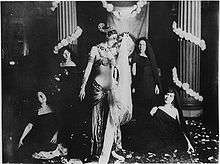
In 1903, Zelle moved to Paris, where she performed as a circus horse rider using the name Lady MacLeod, much to the disapproval of the Dutch MacLeods. Struggling to earn a living, she also posed as an artist's model.
By 1905, Mata Hari began to win fame as an exotic dancer. She was a contemporary of dancers Isadora Duncan and Ruth St. Denis, leaders in the early modern dance movement, which around the turn of the 20th century looked to Asia and Egypt for artistic inspiration. Critics would later write about this and other such movements within the context of Orientalism. Gabriel Astruc became her personal booking agent.[6]
Promiscuous, flirtatious, and openly flaunting her body, Mata Hari captivated her audiences and was an overnight success from the debut of her act at the Musée Guimet on 13 March 1905.[11] She became the long-time mistress of the millionaire Lyon industrialist Émile Étienne Guimet, who had founded the Musée. She posed as a Javanese princess of priestly Hindu birth, pretending to have been immersed in the art of sacred Indian dance since childhood. She was photographed numerous times during this period, nude or nearly so. Some of these pictures were obtained by MacLeod and strengthened his case in keeping custody of their daughter.
Mata Hari brought a carefree provocative style to the stage in her act, which garnered wide acclaim. The most celebrated segment of her act was her progressive shedding of clothing until she wore just a jeweled bra and some ornaments upon her arms and head.[6] She was seldom seen without a bra as she was self-conscious about being small-breasted. She wore a bodystocking for her performances that was similar in color to her own skin.[8]
Although Mata Hari's claims about her origins were fictitious, it was very common for entertainers of her era to invent colorful stories about their origins as part of the show. Her act was successful because it elevated exotic dance to a more respectable status and so broke new ground in a style of entertainment for which Paris was later to become world-famous. Her style and free-willed attitude made her a popular woman, as did her eagerness to perform in exotic and revealing clothing. She posed for provocative photos and mingled in wealthy circles. Since most Europeans at the time were unfamiliar with the Dutch East Indies, Mata Hari was thought of as exotic, and it was assumed her claims were genuine. One evidently enthused French journalist wrote in a Paris newspaper that Mata Hari was "so feline, extremely feminine, majestically tragic, the thousand curves and movements of her body trembling in a thousand rhythms."[12] One journalist in Vienna wrote after seeing one of her performances that Mata Hari was "slender and tall with the flexible grace of a wild animal, and with blue-black hair" and that her face "makes a strange foreign impression."[12]
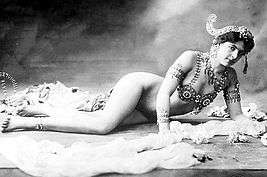
By about 1910, a myriad of imitators had arisen. Critics began to opine that the success and dazzling features of the popular Mata Hari were due to cheap exhibitionism and lacked artistic merit. Although she continued to schedule important social events throughout Europe, she was held in disdain by serious cultural institutions as a dancer who did not know how to dance.[6]
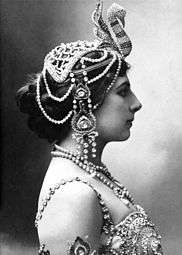
Mata Hari's career went into decline after 1912. On 13 March 1915, she performed in what would be the last show of her career.[13] She had begun her career relatively late for a dancer, and had started putting on weight. However, by this time she had become a successful courtesan, known more for her sensuality and eroticism than for her beauty. She had relationships with high-ranking military officers, politicians, and others in influential positions in many countries. Her relationships and liaisons with powerful men frequently took her across international borders. Prior to World War I, she was generally viewed as an artist and a free-spirited bohemian, but as war approached, she began to be seen by some as a wanton and promiscuous woman, and perhaps a dangerous seductress.
"Double agent"
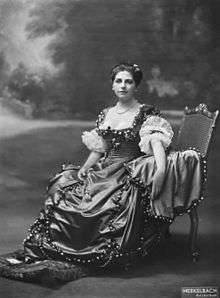
During World War I, the Netherlands remained neutral. As a Dutch subject, Zelle was thus able to cross national borders freely. To avoid the battlefields, she travelled between France and the Netherlands via Spain and Britain, and her movements inevitably attracted attention. During the war, Zelle was involved in what was described as a very intense romantic-sexual relationship with a Russian pilot, the twenty-five year old Captain Vadim Maslov serving with the French, whom she called the love of her life.[7] Maslov was part of the 50,000 strong Russian Expeditionary Force sent to the Western Front in the spring of 1916. In the summer of 1916, Maslov was shot down and badly wounded during a dogfight with the Germans, losing his sight in both eyes, which led Zelle to ask for permission to visit her wounded lover at the hospital where he was staying near the front.[7] As a citizen of a neutral country, Zelle would not normally be allowed near the front. Zelle was met by agents from the Deuxième Bureau who told her that she would only be allowed to see Maslov if she agreed to spy on Germany.[7] Before the war, Zelle had performed as Mata Hari several times before the Crown Prince Wilhelm, eldest son of Kaiser Wilhelm II and nominally a senior German general on the Western Front.[7] The Deuxième Bureau believed she might be able to seduce the Crown Prince and learn valuable German secrets.[7] In fact, the Crown Prince Wilhelm was an irresponsible playboy noted only for his love of women, partying and alcohol and his actual role as a commander was strictly minimal, but the French were not aware of this.[7] The German government understandably was not anxious to publicise the fact that the man expected to be the next Kaiser was a spoiled and immature playboy who when not partying spent his time intriguing with far right-wing politicians to have his father declared insane, so he could become Emperor or at very least Regent, and instead promoted the image of the Crown Prince as a great warrior, the worthy successor to the august Hohenzollern monarchs who had made Prussia strong and powerful.[14] Unaware that the Crown Prince did not have much to do with the running of Army Group Crown Prince or the 5th Army, the Deuxième Bureau offered Zelle one million francs if she could seduce him and provide France with good intelligence about German plans.[7] The fact that the Crown Prince had, before 1914, never commanded a unit larger than a regiment, and was now supposedly commanding both an army and an army group at the same time should have been a clue that his role in German decision-making was mostly nominal. Zelle's contact with the Deuxième Bureau was Captain Georges Ladoux, who was later to emerge as one of her principal accusers.[12]
In November 1916, she was travelling by steamer from Spain when her ship called at the British port of Falmouth. There she was arrested and brought to London where she was interrogated at length by Sir Basil Thomson, Assistant Commissioner at New Scotland Yard in charge of counter-espionage. He gave an account of this in his 1922 book Queer People, saying that she eventually admitted to working for the Deuxième Bureau. Initially detained in Cannon Street police station, she was then released and stayed at the Savoy Hotel. A full transcript of the interview is in Britain's National Archives and was broadcast, with Mata Hari played by Eleanor Bron, on the independent station London Broadcasting in 1980. It is unclear if she lied on this occasion, believing the story made her sound more intriguing, or if French authorities were using her in such a way but would not acknowledge her due to the embarrassment and international backlash it could cause.
In late 1916, Zelle travelled to Madrid, where she met with the German military attaché, Major Arnold Kalle, and asked if he could arrange a meeting with the Crown Prince.[15] During this period, Zelle apparently offered to share French secrets with Germany in exchange for money, though whether this was because of greed or an attempt to set up a meeting with Crown Prince Wilhelm remains unclear.[15] In January 1917, Major Kalle transmitted radio messages to Berlin describing the helpful activities of a German spy code-named H-21, whose biography so closely matched Zelle's that it was patently obvious that Agent H-21 could only be Mata Hari.[15] The Deuxième Bureau intercepted the messages and, from the information it contained, identified H-21 as Mata Hari. The messages were in a code that German intelligence knew had already been broken by the French, leaving to the conclusion that the messages were contrived to have Zelle arrested by the French.[15][16] General Walter Nicolai, the chief IC (intelligence officer) of the German Army had grown very annoyed that Mata Hari had provided him with no intelligence worthy of the name, instead selling the Germans mere Paris gossip about the sex lives of French politicians and generals, and decided to terminate her employment by exposing her as a German spy to the French.[17]
Trial and execution
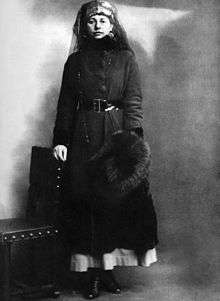
In December 1916, the French Second Bureau of the French War Ministry let Mata Hari obtain the names of six Belgian agents. Five were suspected of submitting fake material and working for the Germans, while the sixth was suspected of being a double agent for Germany and France. Two weeks after Mata Hari had left Paris for a trip to Madrid, the double agent was executed by the Germans, while the five others continued their operations. This development served as proof to the Second Bureau that the names of the six spies had been communicated by Mata Hari to the Germans.[18]
On 13 February 1917, Mata Hari was arrested in her room at the Hotel Elysée Palace on the Champs Elysées in Paris. She was put on trial on 24 July, accused of spying for Germany, and consequently causing the deaths of at least 50,000 soldiers. Although the French and British intelligence suspected her of spying for Germany, neither could produce definite evidence against her. Supposedly secret ink was found in her room, which was incriminating evidence in that period. She contended that it was part of her makeup.[19] Zelle's principal interrogator was Captain Pierre Bouchardon, the man who was to prosecute her at her trial, who grilled her relentlessly.[12] Bouchardon was able to establish that much of the Mata Hari persona was invented, and far from being a Javanese princess, Zelle was actually Dutch, which he was to use as evidence of her dubious and dishonest character at her trial. Zelle admitted to Bouchardon that she had accepted 20,000 francs from a German diplomat in the Netherlands to spy on France, but insisted she only passed on to the Germans trivial information as her loyalty was entirely to her adopted nation, France.[12] In the meantime, Ladoux had been preparing a case against his former agent by casting all of her activities in the worse possible light, going so far as to engage in evidence tampering.[12]
In 1917, France had been badly shaken by the Great Mutinies of the French Army in the spring of 1917 following the failure of the Nivelle Offensive together with a huge strike wave, and at the time, many believed that France might simply collapse as a result of war exhaustion. In July 1917, a new government under Georges Clemenceau aka "le tigre" had come into power, utterly committed to winning the war. In this context, having one German spy for whom everything that went wrong with the war so far could be blamed was most convenient for the French government, making Mata Hari the perfect scapegoat, which explains why the case against her received maximum publicity in the French press, and led to her importance in the war being greatly exaggerated.[20] The Canadian historian Wesley Wark stated in a 2014 interview that Mata Hari was never an important spy and just made a scapegoat for French military failures which she had nothing to do with, stating: "They needed a scapegoat and she was a notable target for scapegoating".[21] Likewise, the British historian Julie Wheelwright stated: "She really did not pass on anything that you couldn’t find in the local newspapers in Spain".[21] Wheelwright went on to describe Zelle as "...an independent woman, a divorcee, a citizen of a neutral country, a courtesan and a dancer, which made her a perfect scapegoat for the French, who were then losing the war. She was kind of held up as an example of what might happen if your morals were too loose”.[21]
Zelle wrote several letters to the Dutch Ambassador in Paris, claiming her innocence. "My international connections are due of my work as a dancer, nothing else .... Because I really did not spy, it is terrible that I cannot defend myself".[22] The most terrible and heart-breaking moment for Mata Hari during the trial occurred when her lover Maslov – by now a deeply embittered man as a result of losing his eyes in combat – declined to testify for her, telling her he couldn't care less if she was convicted or not.[23] It was reported that Zelle fainted when she learned that Maslov had abandoned her.[24] Her defence attorney, veteran international lawyer Édouard Clunet, faced impossible odds; he was denied permission either to cross-examine the prosecution's witnesses or to examine his own witnesses directly. Bouchardon used the very fact that Zelle was a woman as evidence of her guilt, saying: "Without scruples, accustomed to make use of men, she is the type of woman who is born to be a spy."[12] Under the circumstances, her conviction was a foregone conclusion.
Mata Hari herself admitted under interrogation to taking money to work as a German spy. It is contended by some historians that Mata Hari may have merely accepted money from the Germans without actually carrying out any spy duties.[25] At her trial, Zelle vehemently insisted that her sympathies were with the Allies and declared her passionate love of France, her adopted homeland. In October 2001, documents released from the archives of MI5 (British counter-intelligence) were used by a Dutch group, the Mata Hari Foundation to ask the French government to exonerate Zelle as they argued that the MI5 files proved she was not guilty of the charges she was convicted of.[26] A spokesman from the Mata Hari Foundation argued that at most Zelle was a low-level spy who provided no secrets to either side, stating: "We believe that there are sufficient doubts concerning the dossier of information that was used to convict her to warrant re-opening the case. Maybe she wasn't entirely innocent, but it seems clear she wasn't the master-spy whose information sent thousands of soldiers to their deaths, as has been claimed.".[27]
Zelle was not tied to the stake, and refused a blindfold. She defiantly blew a kiss to the firing squad.[15] She was executed by firing squad on 15 October 1917, at the age of 41. Mata Hari, which means "Eye of the Dawn" died at dawn. Zelle has often been portrayed as a femme fatale, the dangerous, seductive woman who uses her sexuality to effortlessly manipulate men, but in reality, she was in the words of the American historians Norman Polmer and Thomas Allen "naïve and easily duped", a victim of men rather than a victimizer.[7]
Disappearance and rumours
| Wikisource has original text related to this article: |
Mata Hari's body was not claimed by any family members and was accordingly used for medical study. Her head was embalmed and kept in the Museum of Anatomy in Paris, but in 2000, archivists discovered that the head had disappeared, possibly as early as 1954, when the museum had been relocated. Records dated from 1918 show that the museum also received the rest of the body, but none of the remains could later be accounted for.
A 1934 New Yorker article reported that at her execution she wore "a neat Amazonian tailored suit, especially made for the occasion, and a pair of new white gloves"[28] though another account indicates she wore the same suit, low-cut blouse and tricorn hat ensemble which had been picked out by her accusers for her to wear at trial, and which was still the only full, clean outfit which she had in prison.[10] Neither description matches photographic evidence. According to an eyewitness account by British reporter Henry Wales, she was not bound and refused a blindfold. Wales records her death, saying that after the volley of shots rang out, "Slowly, inertly, she settled to her knees, her head up always, and without the slightest change of expression on her face. For the fraction of a second it seemed she tottered there, on her knees, gazing directly at those who had taken her life. Then she fell backward, bending at the waist, with her legs doubled up beneath her." A non-commissioned officer then walked up to her body, pulled out his revolver, and shot her in the head to make sure she was dead.[29]
Museum

The Fries Museum in Leeuwarden, the Netherlands, contains a "Mata Hari Room". Included in the exhibit are two of her personal scrapbooks and an oriental rug embroidered with the footsteps of her fan dance.[19] Located in Mata Hari's native town, the museum is well known for research into the life and career of Leeuwarden's world-famous citizen.
Legend and popular culture
The idea of an exotic dancer working as a lethal double agent using her powers of seduction to extract military secrets from her many lovers made Mata Hari an enduring archetype of the femme fatale.[30] Her life inspired a number of films, including Mata Hari, a 1927 German production; Mata Hari (1931) starring Greta Garbo; Mata Hari, Agent H21 (1964) and Mata Hari (1985); and three stage musicals: the first in 1967, starring Pernell Roberts and Marisa Mell, and the second by Lene Lovich, Judge Smith, and Les Chappell, which premiered in 1982 at the Lyric Theatre, Hammersmith. A third, by Frank Wildhorn, debuted in Seoul, South Korea on March 2016. The Dutch Royal Ballet debuted a ballet based on her life on 6 February 2016.
The historical Mata Hari featured as the fictional Indy's first sexual encounter in The Adventures of Young Indiana Jones episode "Demons of Deception", an episode filmed in a different, slightly surreal style (it flashes between present time, and her execution for supposed espionage by the French). The actress who played Mata Hari (Domiziana Giordano) was a slender redhead whereas the historical figure was a slightly plump brunette. In theatre the monologue Mata Hari: A Dawn's Sentence by Jorge Arroyo has been staged in Costa Rica (1987) and Brazil (2002-2003). "The Spy" novel based on her life by the Brazilian author Paulo Coelho will be released on Nov. 22, 2016. Mata Hari also appears as a playable character in the 2015 RPG for the Android/iOS from Type-Moon, Fate/Grand Order, as an Assassin class servant. Mata Hari is the focus of the New York Times bestselling historical fiction author Michelle Moran's new book, Mata Hari's Last Dance. The book was released on July 19, 2016.
Bibliography
- Collas, Phillipe, (2008). Mata Hari, sa véritable Histoire. Paris: Plon 2003. ISBN 978-2-2591-9872-1.
- Coulson, Thomas. Mata Hari: Courtesan and Spy. London: Hutchinson, 1930. OCLC 17969173
- Dumarcet, Lionel: L'affaire Mata-Hari. De Vecchi, Paris 2006, ISBN 2-7328-4870-0 (französisch)
- Howe, Russel Warren: Mata-Hari. The true story. Editions de l'Archipel, Paris 2007, ISBN 978-2-84187-577-1 (französisch)
- Huisman, Marijke. (1998), Mata Hari (1876–1917): de levende legende. Hilversum (Netherlands): Verloren. ISBN 90-6550-442-7.
- Maucher,Ute, Pfeiffer, Gabi: Codewort: Seidenstrumpf, Die größten Spioninnen des 19. und 20. Jahrhunderts. ars vivendi verlag, 2010, ISBN 978-3-89716-999-9.
- Ostrovsky, Erika. (1978), Eye of Dawn: The Rise and Fall of Mata Hari. New York: Macmillan. ISBN 0025940309 OCLC 3433352
- Samuels, Diane: The true life fiction of Mata Hari. Hern Books, London 2002, ISBN 1-85459-672-1 (englisch)
- Shipman, Pat. (2007), Femme Fatale: Love, Lies, and the Unknown Life of Mata Hari. London: Weidenfeld & Nicolson ISBN 0-297-85074-1
- Waagenaar, Sam. (1965), Mata Hari. New York: Appleton-Century.
- Wheelwright, Julie. (1992). The Fatal Lover: Mata Hari and the Myth of Women in Espionage. London: Collins and Brown. ISBN 1-85585-128-8.
See also
References
- ↑ Howe, Russel Warren (1986). Mata Hari: The True Story. New York: Dodd, Mead and Company. pp. x–xi, 285.
- ↑ "Mata Hari". Encyclopædia Britannica. Retrieved 21 August 2007.
The daughter of a prosperous hatter, she attended a teachers' college in Leiden. In 1895 she married an officer whose family was of Scottish origin, Captain Rudolph MacLeod, in the Dutch colonial army, and from 1897 to 1902 they lived in Java and Sumatra. The couple returned to Europe but later separated, and she began to dance professionally in Paris in 1905 under the name of Lady MacLeod. She soon called herself Mata Hari, said to be a Malay expression for the sun (literally, "eye of the day"). Tall, extremely attractive, superficially acquainted with East Indian dances, and willing to appear virtually nude in public, she was an instant success in Paris and other large cities.
- ↑ Her birth house, at Kelders 33, survived a big fire that destroyed the three houses immediately next to it on 19 October 2013.
- ↑ Ancestors of Margaretha Geertruida ZELLE. www.praamsma.org
- 1 2 3 Jennifer Rosenberg Mata Hari. About.com
- 1 2 3 4 5 6 7 8 9 Mata Hari at the Wayback Machine (archived 15 September 2010). World of Biography
- 1 2 3 4 5 6 7 8 9 https://books.google.co.uk/books?id=U_G6BAAAQBAJ&pg=PT52&lpg=PT52&dq=Margaretha+Zelle+eurasian&source=bl&ots=DMgosSiT24&sig=NqZlkas9TFCpC6SbrbeQx73xPhc&hl=en&sa=X&ved=0ahUKEwjn8snOkL3PAhUCOxQKHTAtCogQ6AEINTAE
- 1 2 3 4 Denise Noe Mata Hari. Crimelibrary.com. Retrieved on 15 October 2011.
- ↑ The Spy Who Never Was, written by Julia Keay, published by Michael Joseph Ltd, 1987
- 1 2 Shipman, Pat (2007). Femme Fatale: Love, Lies, and the Unknown Life of Mata Hari. New York: HarperCollins. p. 450. ISBN 0-06-081728-3.
- ↑ Denise Noe Mata Hari is Born. Crimelibrary.com
- 1 2 3 4 5 6 7 "Biography of Mata Hari". The Biography Channel. May 2016. Retrieved 2016-08-10.
- ↑ Mata Hari- The True Story. By Russell Warren Howe, pg. 63. 1986
- ↑ Wheeler-Bennett, John The Nemesis of Power The German Army In Politics 1918-1945, London: Macmillian, 1967 pages 12-13.
- 1 2 3 4 5 Polmer, Norman & Allen, Thomas The Spy Book, New York: Random House, 1998 page 358.
- ↑ Howe, Russel Warren (1986). Mata Hari: The True Story. New York: Dodd, Mead and Company. pp. 143.
- ↑ Polmer, Norman & Allen, Thomas The Spy Book, New York: Random House, 1998 page 394.
- ↑ Waagenaar: Sie nannte sich Mata Hari, page 258
- 1 2 Mata Hari. German Spy. World War I. Sameshield.com. Retrieved on 15 October 2011.
- ↑ Arbuckle, Alex (May 2016). "The Dramatic Tale of Mata Hari Dancer, courtesan, scapegoat, spy?". Retronaught. Retrieved 2016-08-10.
- 1 2 3 Edwards, Peter (24 April 2014). "Condemned spy Mata Hari glib during final interrogation: MI5 files". The Toronto Star. Retrieved 2016-08-10.
- ↑ Brieven van Mata Hari (Letters of Mata Hari). Dutch National Archives. Gahetna.nl. 17 June 2011 Retrieved on 15 October 2011. (in Dutch)
- ↑ Cockfield, Jamie With Snow on Their Boots: The Tragic Odyssey of the Russian Expeditionary Force in France During World War I, London: Macmillan, 1999 pages 330-331.
- ↑ Cockfield, Jamie With Snow on Their Boots: The Tragic Odyssey of the Russian Expeditionary Force in France During World War I, London: Macmillan, 1999 page 331.
- ↑ Shipman, Pat (2007). Femme Fatale: Love, Lies, and the Unknown Life of Mata Hari. New York: HarperCollins.
- ↑ Jeffries, Stuart (16 October 2001). "Did they get Mata Hari wrong?". The Guardian. Retrieved 2016-08-10.
- ↑ Jeffries, Stuart (16 October 2001). "Did they get Mata Hari wrong?". The Guardian. Retrieved 2016-08-10.
- ↑ Flanner, Janet (1979). Paris was Yesterday: 1925–1939. New York: Penguin. p. 126. ISBN 0-14-005068-X.
- ↑ Execution of Mata Hari. Eyewitnesstohistory.com (19 October 1917). Retrieved on 2011-10-15.
- ↑ Samuels, Diane (2002). The True Life Fiction of Mata Hari. Nick Hern Books. ISBN 978-1854596727.
External links
| Wikimedia Commons has media related to Mata Hari. |
| Library resources about Mata Hari |
- Biography at Court TV's Crime Library
- Multi-language (nl, fr, de, en) website on Mata Hari
- Details of the disappearance of the corpse
- "The Execution of Mata Hari, 1917," EyeWitness to History, www.eyewitnesstohistory.com (2005)
- Mata-Hari.com: Pictures and Photos of Mata Hari (English + Deutsch + Español + Português + Français + Italiano)